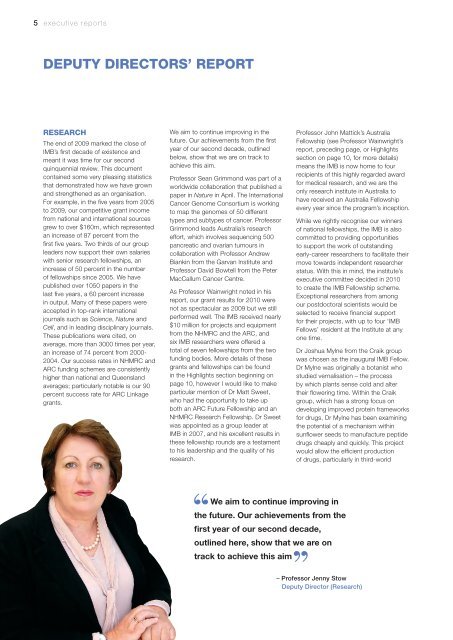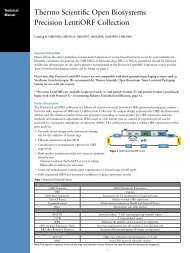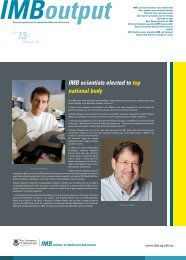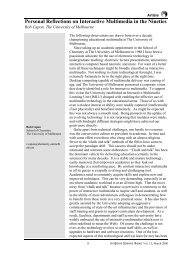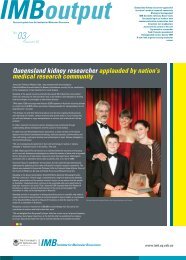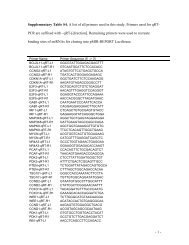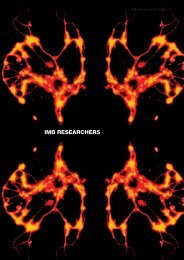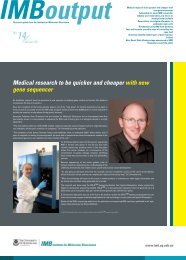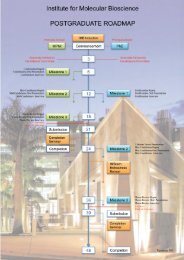2010 Annual Report - Institute for Molecular Bioscience - University ...
2010 Annual Report - Institute for Molecular Bioscience - University ...
2010 Annual Report - Institute for Molecular Bioscience - University ...
You also want an ePaper? Increase the reach of your titles
YUMPU automatically turns print PDFs into web optimized ePapers that Google loves.
5 executive reports<br />
DEPUTY DIRECTORS’ REPORT<br />
RESEARCH<br />
The end of 2009 marked the close of<br />
IMB’s first decade of existence and<br />
meant it was time <strong>for</strong> our second<br />
quinquennial review. This document<br />
contained some very pleasing statistics<br />
that demonstrated how we have grown<br />
and strengthened as an organisation.<br />
For example, in the five years from 2005<br />
to 2009, our competitive grant income<br />
from national and international sources<br />
grew to over $160m, which represented<br />
an increase of 87 percent from the<br />
first five years. Two thirds of our group<br />
leaders now support their own salaries<br />
with senior research fellowships, an<br />
increase of 50 percent in the number<br />
of fellowships since 2005. We have<br />
published over 1050 papers in the<br />
last five years, a 60 percent increase<br />
in output. Many of these papers were<br />
accepted in top-rank international<br />
journals such as Science, Nature and<br />
Cell, and in leading disciplinary journals.<br />
These publications were cited, on<br />
average, more than 3000 times per year,<br />
an increase of 74 percent from 2000-<br />
2004. Our success rates in NHMRC and<br />
ARC funding schemes are consistently<br />
higher than national and Queensland<br />
averages; particularly notable is our 90<br />
percent success rate <strong>for</strong> ARC Linkage<br />
grants.<br />
We aim to continue improving in the<br />
future. Our achievements from the first<br />
year of our second decade, outlined<br />
below, show that we are on track to<br />
achieve this aim.<br />
Professor Sean Grimmond was part of a<br />
worldwide collaboration that published a<br />
paper in Nature in April. The International<br />
Cancer Genome Consortium is working<br />
to map the genomes of 50 different<br />
types and subtypes of cancer. Professor<br />
Grimmond leads Australia’s research<br />
ef<strong>for</strong>t, which involves sequencing 500<br />
pancreatic and ovarian tumours in<br />
collaboration with Professor Andrew<br />
Biankin from the Garvan <strong>Institute</strong> and<br />
Professor David Bowtell from the Peter<br />
MacCallum Cancer Centre.<br />
As Professor Wainwright noted in his<br />
report, our grant results <strong>for</strong> <strong>2010</strong> were<br />
not as spectacular as 2009 but we still<br />
per<strong>for</strong>med well. The IMB received nearly<br />
$10 million <strong>for</strong> projects and equipment<br />
from the NHMRC and the ARC, and<br />
six IMB researchers were offered a<br />
total of seven fellowships from the two<br />
funding bodies. More details of these<br />
grants and fellowships can be found<br />
in the Highlights section beginning on<br />
page 10, however I would like to make<br />
particular mention of Dr Matt Sweet,<br />
who had the opportunity to take up<br />
both an ARC Future Fellowship and an<br />
NHMRC Research Fellowship. Dr Sweet<br />
was appointed as a group leader at<br />
IMB in 2007, and his excellent results in<br />
these fellowship rounds are a testament<br />
to his leadership and the quality of his<br />
research.<br />
Professor John Mattick’s Australia<br />
Fellowship (see Professor Wainwright’s<br />
report, preceding page, or Highlights<br />
section on page 10, <strong>for</strong> more details)<br />
means the IMB is now home to four<br />
recipients of this highly regarded award<br />
<strong>for</strong> medical research, and we are the<br />
only research institute in Australia to<br />
have received an Australia Fellowship<br />
every year since the program’s inception.<br />
While we rightly recognise our winners<br />
of national fellowships, the IMB is also<br />
committed to providing opportunities<br />
to support the work of outstanding<br />
early-career researchers to facilitate their<br />
move towards independent researcher<br />
status. With this in mind, the institute’s<br />
executive committee decided in <strong>2010</strong><br />
to create the IMB Fellowship scheme.<br />
Exceptional researchers from among<br />
our postdoctoral scientists would be<br />
selected to receive financial support<br />
<strong>for</strong> their projects, with up to four ‘IMB<br />
Fellows’ resident at the <strong>Institute</strong> at any<br />
one time.<br />
Dr Joshua Mylne from the Craik group<br />
was chosen as the inaugural IMB Fellow.<br />
Dr Mylne was originally a botanist who<br />
studied vernalisation – the process<br />
by which plants sense cold and alter<br />
their flowering time. Within the Craik<br />
group, which has a strong focus on<br />
developing improved protein frameworks<br />
<strong>for</strong> drugs, Dr Mylne has been examining<br />
the potential of a mechanism within<br />
sunflower seeds to manufacture peptide<br />
drugs cheaply and quickly. This project<br />
would allow the efficient production<br />
of drugs, particularly in third-world<br />
We aim to continue improving in<br />
the future. Our achievements from the<br />
first year of our second decade,<br />
outlined here, show that we are on<br />
track to achieve this aim<br />
’’<br />
– Professor Jenny Stow<br />
Deputy Director (Research)


